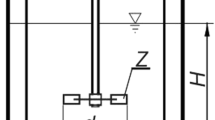Abstract
In order to study the influence that the processing parameters exert on the rheology and stability of salad dressing emulsions, both steady-state shear and oscillatory measurements, as well as droplet size distribution tests were performed. Emulsions containing a mixture of egg yolk and sucrose stearate as emulsifier were prepared using two different emulsification machines, a rotor-stator turbine and a colloidal mill. An increase both in energy input and in the temperature of processing yields higher values of the steady-state viscosity, an increase in emulsion stability and, generally, lower droplet size and lower polydispersity. Furthermore, a plateau region in the loss modulus versus frequency plots appears as the energy input and processing temperature increase. This effect has been analyzed by calculating the relaxation spectra of these emulsions. The results have been discussed taking into account the relationship between several structural parameters, such as interparticle interactions and droplet size distribution, and the rheological response of these emulsions.
Similar content being viewed by others
References
Barnes HA, Hutton JF, Walters K (1989) An introduction to rheology. Rheology series 3, Elsevier, Amsterdam
Baumgaertel M, Schausberger A, Winter HH (1990) The relaxation of polymers with linear flexible chains of uniform length. Rheol Acta 29:400–408
Baumgaertel M, De Rosa ME, Machado J, Masse M, Winter HH (1992) The relaxation time spectrum of nearly monodisperse polybutadiene melts. Rheol Acta 31:75–82
Bird RB, Armstrong RC, Hassager O, Curtis CE (1987) Dynamics of polymeric liquid, 2nd ed. Wiley, New York
Calahorro C, Muñoz J, Berjano M, Guerrero A, Gallegos C (1992) Flow behaviour of sucrose stearate/water systems. J Am Oil Chem Soc 69:660–666
Carrillo AR, Kokini JL (1988) Effect of egg yolk and egg yolk+salt on rheological properties and particle size distribution of model oil-in-water salad dressing emulsions. J Food Sci 53:1352–1355
Cavallo JL, Chang DL, Saleeb FZ (1990) Formulation considerations in emulsion preparation and stability. AIChE Symposium Series 86:16–24
Clark DC, Wilde PJ, Wilson DR, Wunsteck RC (1992) The interaction of sucrose esters with β-lactoglobulin β-casein from bovine milk. Food Hydrocoll 6:173–186
Chambon F, Winter HH (1985) Stopping of crosslinking reaction in PDMS polymer at the gel point. Polym Bull 13:499–503
De Rosa ME, Winter HH (1994) The effect of entanglements on the rheological behavior of polybutadiene critical gels. Rheol Acta 33:220–237
Dickinson E (1989) Food colloids — An overview. Colloids Surf 42:191–204
Dickinson E (1994) Interactions in proteinstabilized emulsions. In: Gallegos C (ed) Progress and trends in rheology, IV. Steinkopff, Darmstadt, pp 227–229
Dickinson E, Stainsby G (1987) Progress in the formulation of food emulsions and foams. Food Technol 41:75–81
Dickinson E, Tanai S (1992) Temperature dependence of the competitive displacement of protein for the emulsion droplet surface by surfactants. Food Hydrocoll 6:163–171
Doi M, Edwards SF (1986) The theory of polymer dynamics. Clarendon Press, Oxford
Ebert G, Platz G, Rehage H (1988) Elastic and rheological properties of hydrocarbons gels. Ber Bunsen-Ges Phys Chem 92:1158–1164
Ferry JD (1980) Viscoelastic properties of polymers, 3rd ed. Wildy, New York
Figoni PI, Shoemaker CF (1983) Characterization of time dependent flow properties of mayonnaise under steady shear. J Texture Stud 14:431–442
Franco JM, Berjano M, Guerrero A, Munoz J, Gallegos C (1995a) Flow behaviour and stability of light mayonnaise containing a mixture of egg yolk and sucrose stearate as emulsifiers. Food Hydrocoll 9:111–121
Franco JM, Trujillo JE, Algeciras JL, Gallegos C (1995b) Estabilización de emulsiones alimentarias aceite en aqua por modificación del contenido en emulsionante y estabilizante. Alim Equip Tecnol (accepted)
Gallegos C, Berjano M, Choplin L (1992) Linear viscoelastic behaviour of commercial and model mayonnaise. J Rheol 36:465–478
Kato A, Nakai S (1980) Hydrophobicity determined by fluorescence probe method and its correlation with surface properties of proteins. Biochim Biophys Acta 624:13–20
Muñoz J, Sherman P (1992) Dynamic viscoelastic properties of some commercial salad dressings. J Texture Stud 21:411–426
Pal R, Rhodes E (1989) Viscosity/concentration relationships for emulsions. J Rheol 33:1021–1045
Partal P, Guerrero A, Berjano M, Muñoz J, Gallegos C (1994) Flow behaviour and stability of oil-in-water emulsions stabilized by a sucrose palmitate. J Texture Stud 25:331–348
Rahalkar RR (1992) Viscoelastic properties of oil-water emulsions. In: Rao MA, Steffe JF (eds) Viscoelastic properties of food. Elsevier, London, pp 317–354
Rivas HJ, Sherman P (1983) Soy and meat proteins as food emulsion stabilizers. 2. Influence of emulsification temperature, NaCl and methanol on the viscoelastic properties of corn oil-in-water emulsions incorporating acid precipitated soy protein. J Texture Stud 14:267–275
Tadros ThF (1990) Use of viscoelastic measurements in studying interactions in concentrated dispersions. Langmuir 6:28–35
Tschoegl NW (1989) The phenomenological theory of linear viscoelastic behaviour. Springer-Verlag, Heidelberg
Walstra P (1983) Formation of emulsions. In: Becher P (ed) Encyclopedia of emulsion technology, vol. I. Marcel Dekker, New York, pp 57–127
Wu S (1989) Chain structure and entanglement. J Polym Sci 27:723–741
Author information
Authors and Affiliations
Rights and permissions
About this article
Cite this article
Franco, J.M., Guerrero, A. & Gallegos, C. Rheology and processing of salad dressing emulsions. Rheola Acta 34, 513–524 (1995). https://doi.org/10.1007/BF00712312
Received:
Accepted:
Issue Date:
DOI: https://doi.org/10.1007/BF00712312



